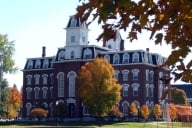You have /5 articles left.
Sign up for a free account or log in.
More students enrolled in United States medical schools than ever before in 2008, according to new data from the Association of American Medical Colleges. The rate of growth, however, slowed for the first time since 2003. Additionally, the number of applicants fell for the first time since 2002.
These mixed results will make it difficult for medical schools nationwide to meet the 30 percent increase in first-year enrollment the AAMC recommends from 2002 to 2015. So far, there has only been 9 percent growth since 2002.
Darrell G. Kirch, AAMC president, said he believed medical schools were still on track to meet the goal. Plans to increase the capacity of a number of the AAMC’s 130 U.S. member institutions -- three of which opened new branches this year -- will help meet this goal, he said. In April, the AAMC reported that 6 new medical schools were in the formal process of earning accreditation.
Moreover, he said, it is not prudent to over-analyze small changes in enrollment and applicant data, adding that they are only one part of a multifaceted approach to meet the increasing demand for physicians in the U.S.
“It is a mistake to view the number of first-year [medical school] students as the only or primary determinate in the workforce,” Kirch said. He noted that a number of doctors come from abroad to practice in the U.S. Additionally, he said, the retirement decisions of aging physicians will likely have at least as much of an impact on the size of the M.D. population in the near future as will the sizes of entering medical school classes.
Trends in Medical School Enrollments and Applications, 1998-2008
| Year | Total First-Year Enrollment | % Change in Enrollment | Total Applicants | % Change in Applicants | Applicants per Spot |
| 1998 | 16,170 | 0.0 % | 40,996 | -4.7 % | 2.5 |
| 1999 | 16,221 | +0.3 % | 38,443 | -6.2 % | 2.4 |
| 2000 | 16,301 | +0.5 % | 37,088 | -3.5 % | 2.3 |
| 2001 | 16,365 | +0.4% | 34,860 | -6.0 % | 2.1 |
| 2002 | 16,488 | +0.8 % | 33,625 | -3.5 % | 2.0 |
| 2003 | 16,541 | +0.3 % | 34,791 | +3.5 % | 2.1 |
| 2004 | 16,648 | +0.6 % | 35,735 | +2.7 % | 2.1 |
| 2005 | 17,003 | +2.1 % | 37,373 | +4.6 % | 2.2 |
| 2006 | 17,361 | +2.1 % | 39,108 | +4.6 % | 2.3 |
| 2007 | 17,759 | +2.3 % | 42,315 | +8.2 % | 2.4 |
| 2008 | 18,036 | +1.6 % | 42,231 | -0.2 % | 2.3 |
(Source: AAMC Data Warehouse: Applicant Matriculant File as of October 10, 2008)
Though Kirch trumpets enrollment increases in the short term, he warns that there has not been a commensurate increase in the number of slots in residency programs to accommodate these students. The 1997 Balanced Budget Act, signed by President Bill Clinton, established a cap on the number of post-M.D. medical training positions funded my Medicare at teaching hospitals nationwide. In spite of this, Kirsch said many individual hospitals have decided to fund additional positions to meet the needs of their communities. Without a conscious national effort to increase the capacity of Graduate Medical Education, Kirch said the U.S. will increasingly depend on foreign graduates in the medical field.
In other details from the new AAMC data, the number of minority enrollees and applicants grew this year. Latinos represent almost 8 percent of this year’s entering medical school class, and the number of Latino enrollees increased by more than 10 percent over last year. Additionally, the number of Latino applicants rose by 3 percent. African American enrollee numbers remained relatively the same, representing around 7 percent of this year’s entering class. There was, however, a 4 percent decrease in the number of African American applicants from last year.
Of the three medical schools that opened new branches this year, two are in rapidly growing Latino communities. Texas A&M Health Science Center College of Medicine and the University of Arizona College of Medicine together account for most of the enrollment increases this year, including some of the significant Latino enrollment increases. Mercer University School of Medicine, based in Macon, Ga., also opened a new campus in Savannah, Ga. this fall.
Summer Morgan, spokeswoman for Texas A&M, said its medical school’s new fourth campus in Round Rock increased its overall first-year enrollment from 100 students last year to 139 this year. She said the system’s Board of Regents recently approved a plan to increase first-year enrollment capacity to 175 next year and to 200 students within the next three to four years. Of the school’s 2037 applicants this year, 11 percent are Latino; of the school’s 139 enrollees, 12 percent are Latino.
Al Bravo, Arizona spokesman, said its medical school has similar demographics. As nearly 25 percent of the state’s population is Latino, he said it is the medical school’s goal to mirror this figure. Minority students consist of 15 percent of the medical school’s entering class, and Bravo said the lion’s share of them are Latino. The school’s overall growth, however, is because of the opening of a new campus in downtown Phoenix -- which houses 48 first-year students this year. The prime location allows graduates a larger number of hospitals where they can pursue their residencies, Bravo said. While the long-term plan is to keep the main college campus at Tucson near a 110-student cap per class, he added, the school wants to accommodate nearly 150 students per class in Phoenix within the next eight to 10 years.
New medical school branches and outlets such as these will help the country meet the overwhelming demand for more physicians, Kirch said, adding that the recent economic downturn will only drive students to the profession.
“Schools are being conscious of their communities’ needs,” Kirch said. “In times of uncertainty or turmoil, the enduring worth of careers in health care, especially as a physician, tends to stand out"








